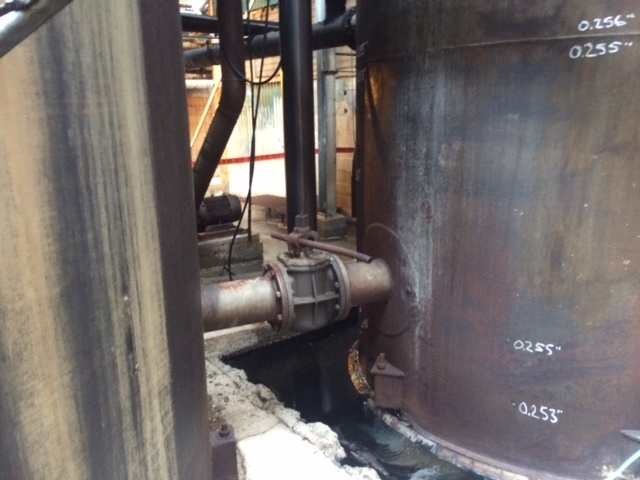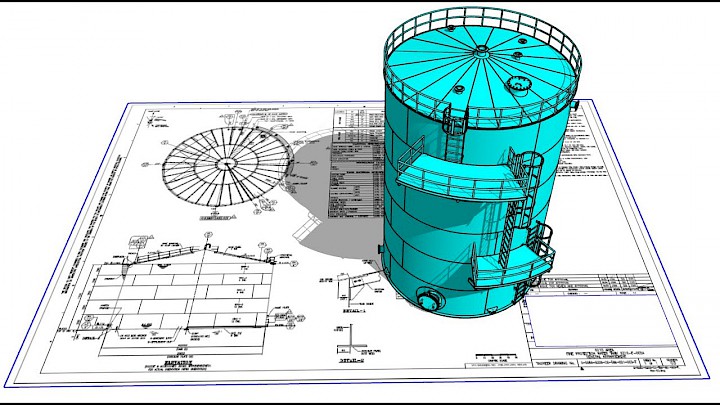Learning About the Requirements That Govern API 650 Welding Inspection
Wiki Article
Exactly How Welding Examination Works: A Comprehensive Overview for Professionals
Welding assessment plays a crucial function in making certain the safety and security and integrity of bonded frameworks. It involves a methodical approach that includes both aesthetic assessment and advanced testing techniques. Specialists need to acquaint themselves with key standards and laws regulating the industry. Recognizing the typical problems that can occur during welding is necessary. This overview will discover these aspects carefully, supplying understandings right into the processes that maintain quality and stability in welding.Comprehending the Relevance of Welding Assessment
While many might take too lightly the relevance of welding inspection, it plays a necessary function in making certain the stability and safety and security of bonded frameworks. Efficient welding examination recognizes prospective problems and imperfections that can compromise architectural strength and bring about devastating failures. The inspection process includes various techniques, such as visual evaluations, ultrasonic screening, and radiographic evaluations, each contributing to the total analysis of weld quality.
In addition to protecting the architectural stability, welding assessment ensures conformity with market requirements and customer specs. By guaranteeing that welds fulfill called for resistances and features, evaluations assist preserve the dependability and durability of parts in numerous applications, from building and construction to aerospace. An extensive inspection process cultivates a culture of quality and liability among producers and welders. Eventually, welding inspection is not simply a step-by-step action; it is a vital technique that underpins the safety and security and efficiency of engineered systems across varied fields.
Trick Specifications and Rules in Welding Examination
The structure of efficient welding inspection hinges on adherence to developed policies and requirements. Different companies, such as the American Welding Society (AWS) and the American National Criteria Institute (ANSI), stated standards that assure high quality and security in welding methods. Trick requirements, such as AWS D1.1 for structural welding and ASME Section IX for stress vessels, give extensive requirements for welding certifications, procedures, and assessments. Regulative frameworks, consisting of those from the Occupational Safety And Security and Wellness Management (OSHA), mandate safety and security techniques and worker securities in welding settings. Conformity with these requirements is important for achieving consistent weld high quality and lessening the threat of failures. Additionally, worldwide criteria like ISO 3834 additionally enhance international uniformity in welding assessment techniques. Specialists have to remain educated regarding these regulations to ensure that their inspection techniques straighten with sector expectations and lawful demands, consequently protecting both workers and structural integrity.Preliminary Prep Work and Aesthetic Inspection Techniques

Efficient welding inspection starts with a complete pre-inspection list that ensures all needed conditions are fulfilled prior to the actual examination occurs. Following this preparation, visual issue recognition plays a necessary duty in evaluating weld top quality, permitting examiners to find problems such as splits or incorrect combination. With each other, these methods develop the foundation for a successful welding inspection procedure.
Pre-Inspection Checklist
Prior to commencing any welding inspection, a thorough pre-inspection list is necessary to guarantee that all necessary prep work are finished and that aesthetic inspection methods are effectively used. Key aspects of this checklist consist of verifying the welding treatment specification (WPS), seeing to it all devices is calibrated and in great functioning condition, and confirming that the assessor has the required accreditations. In addition, it is essential to examine any previous assessment records and to evaluate the workplace for safety and security hazards. The assessor ought to likewise confirm that all pertinent documents, such as material certificates and inspection records, is readily available. Completing this checklist helps to develop a strong structure for an effective examination procedure, boosting the integrity of the outcomes gotten.Visual Defect Identification
An effective aesthetic problem recognition procedure begins with mindful first preparation and the application of recognized visual inspection strategies. Assessors ought to guarantee that the welding location is clean and well-lit, as appropriate exposure is vital for discovering defects. An extensive evaluation of the weld joint's surface area permits the recognition of stoppages, such as fractures, damages, or porosity. Examiners often make use of tools like multiplying glasses or mirrors to improve their sight of hard-to-reach areas. In addition, they ought to recognize with the particular welding criteria and guidelines pertinent to the project. By sticking to these methods, assessors can effectively recognize potential concerns, protecting the integrity of the weld and conformity with industry requirements.Non-Destructive Testing Approaches: A Summary
Non-destructive screening (NDT) approaches play a vital duty in the welding inspection process by making sure the integrity and reliability of welded frameworks without causing any type of damages (API 650 Welding Inspection). These methods permit assessors to assess the top quality of welds while preserving the parts being examined. Usual NDT approaches consist of ultrasonic screening, radiographic screening, magnetic fragment testing, and dye penetrant testing, each offering special benefitsUltrasonic screening uses high-frequency audio waves to identify internal imperfections, while radiographic screening uses X-rays or gamma rays to visualize the interior structure of welds. Magnetic bit testing exposes surface area and near-surface defects by applying an electromagnetic field and iron fragments to the weld location. Dye penetrant screening highlights surface-breaking problems through the application of a tinted dye. Together, these NDT methods offer crucial insights into weld top quality, enabling specialists to make enlightened choices relating learn the facts here now to security and conformity in welding applications.
Common Issues and Their Ramifications
Determining usual flaws in bonded joints is important for preserving structural stability and safety. Various defects can develop throughout the welding process, each carrying possible ramifications for the overall efficiency of the structure. Porosity, characterized by small gas pockets within the weld, can damage the joint and compromise its load-bearing capacity. Cracks might develop as a result of thermal tension or inappropriate air conditioning, causing possible failure under stress. Insufficient blend occurs when the weld steel does not completely click bond with the base product, resulting in weak joints that may not stand up to designated lots. Damaging, where the base steel is deteriorated, can likewise lower the reliable cross-section of the weld. In addition, excessive support can develop anxiety focus that could bring about failure. Acknowledging these issues quickly enables for corrective measures, making certain the long life and reliability of bonded structures in crucial applications.Tools and Tools Utilized in Welding Assessment
Reliable welding inspection relies on a range of specialized tools and tools to guarantee the top quality and stability of bonded joints. Important tools include visual examination devices, such as amplifying borescopes and glasses, which permit assessors to very closely take a look at welds for surface flaws. Non-destructive testing (NDT) methods, such as ultrasonic screening, radiographic testing, and magnetic particle testing, are basic for identifying inner imperfections without harming the product.Measurement devices, consisting of calipers and weld assesses, assist establish and examine dimensions conformity with requirements. In addition, solidity testers assess the mechanical buildings of welded joints. Individual protective equipment (PPE) is also imperative, safeguarding the security of inspectors while functioning in potentially dangerous settings (API 650 Welding Inspection). Each device serves a specific purpose, collectively enhancing the effectiveness of welding inspection and adding to the reliability of finished jobs
Often Asked Concerns
What Certifications Are Needed to Become a Welding Assessor?
To come to be a welding examiner, individuals usually need relevant qualifications, such as AWS CWI or CSWIP, in addition to experience in welding processes, engineering concepts, and understanding of assessment techniques, safety criteria, and suitable codes.Exactly How Frequently Should Welding Inspections Be Conducted?
Welding inspections need to be performed consistently, ideally at different project phases, consisting of pre-weld, during-weld, and post-weld. Regularity may additionally depend upon industry criteria, job requirements, and the complexity of the welds involved.Can Welding Defects Be Fixed After Inspection?

Yes, welding issues can typically be fixed after evaluation. Depending upon the extent and type of flaw, ideal methods such useful link as remodeling or added welding might be employed to restore structural stability and safety and security compliance.
What Industries Require Regular Welding Assessments?

Numerous sectors, consisting of construction, manufacturing, aerospace, and automobile, need routine welding examinations - API 650 Welding Inspection. These inspections guarantee adherence to security criteria and top quality control, decreasing risks related to structural integrity and operational performance in welded components
How Do I Choose a Welding Inspection Service?
To pick a welding examination solution, one must take into consideration certifications, experience, qualifications, and industry track record. In addition, assessing customer testimonials and assuring the service meets pertinent criteria can assist ensure quality inspections and reliable outcomes.
While several may underestimate the value of welding assessment, it plays a vital role in making sure the integrity and safety and security of welded frameworks. Key requirements, such as AWS D1.1 for structural welding and ASME Section IX for stress vessels, offer thorough requirements for welding procedures, assessments, and qualifications. Efficient welding inspection begins with a detailed pre-inspection list that assures all required conditions are fulfilled prior to the real inspection takes place. Before beginning any kind of welding examination, a comprehensive pre-inspection list is crucial to assure that all necessary preparations are completed and that visual evaluation methods are successfully used. Non-destructive testing (NDT) techniques play an essential duty in the welding inspection process by guaranteeing the stability and dependability of welded structures without creating any kind of damages.
Report this wiki page